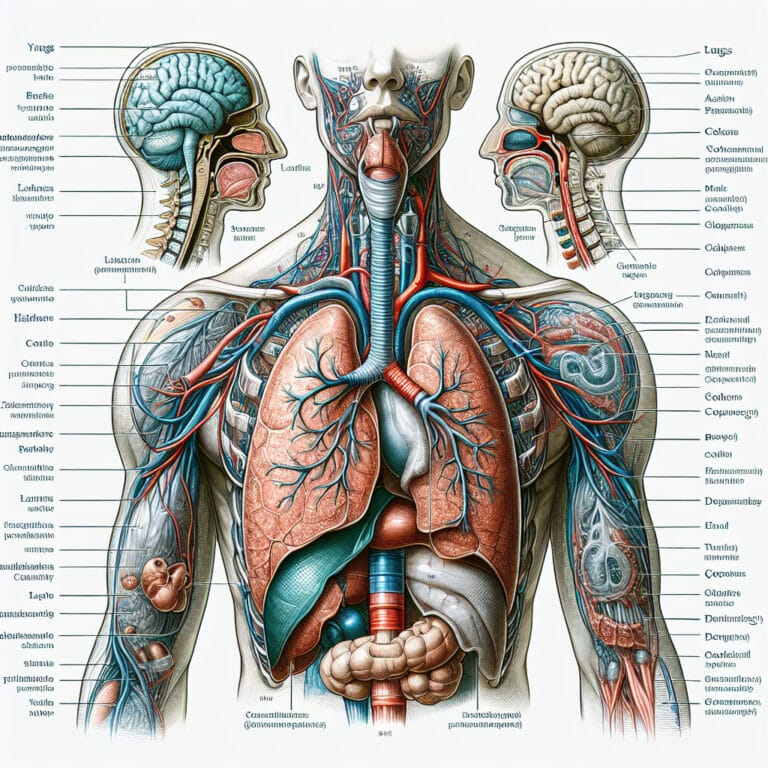
Understanding the Benefits: Nasal Breathing vs Mouth Breathing
Table of Contents
- Understanding the Benefits: Nasal Breathing vs Mouth Breathing
- Understanding Breathing
- Nasal Breathing
- Mouth Breathing
- Comparative Analysis
- Conclusion
- References
- Frequently Asked Questions
Understanding the Benefits: Nasal Breathing vs Mouth Breathing
Breathing, an essential process of life, is often taken for granted until we experience difficulty or discomfort in performing it. While nose and mouth are both conduits for airflow into our lungs, the choice between nasal breathing and mouth breathing carries significant health implications. A comprehensive overview reveals that our bodies were designed to breathe primarily through the nose, which humidifies air, filters and heats incoming oxygen before it reaches your lungs – a feature that distinguishes nasal breathing from oral breathing. Furthermore, nose-breathing stimulates nitric oxide production in our blood vessels thereby positively impacting a person’s ability to oxygenate tissues effectively.
However, various factors such as underlying conditions like deviated septum or chronic nasal congestion can cause some individuals to resort to mouth breathing. This form of respiration can negatively affect one’s health by drying out the oral cavity and worsening symptoms of acute respiratory illnesses due to its lower efficiency in filtering airborne pathogens. In contrast to nasal respiration where diaphragm muscle leading leads the process with assistance from accessory inspiratory muscle activity; mouth-breathing adults rely mostly on thoracic cavity movements making their respiratory muscles work harder leading to fatigue quicker during submaximal exercise.
It is crucial therefore that improper breathing habits be corrected early on via modalities such as deep-breathing exercises or alternate nostril breathing techniques aimed at keeping the mouth closed and promoting nose things like improved airflow. In certain cases, mouth surgical treatment may be recommended alongside use of dental devices specifically designed for this purpose.
Yet beyond these distinctions between nose and mouth-based respiration lies a more holistic understanding: our breath influences not just physical well-being but also impacts aspects such as nervous system regulation—making slow deep breaths through one’s nostrils an effective relaxation technique—and even gut microbiome diversity via mechanisms researchers are still exploring.
This article explains comprehensively why adopting optimal practices aligned with our natural physiology (like prioritising nose over mouth for inhaling) holds immense value. It will further delve into long-term symptoms associated with faulty breathing styles, practical exercises to improve your technique and ways to handle issues like night mouth breathing or nasal congestion. You’ll be surprised how little tweaks in your daily routine can result in substantial health benefits, highlighting the profound connection between our breath and overall wellness.
Understanding Breathing
Delving deeper into the mechanics of breathing, nose breathing is an intricate process that begins with inhaling air through the nostrils. This air is then warmed, humidified and filtered by the nasal cavity’s complex structure before it enters our lungs. The presence of tiny hair-like structures in the nose, called cilia, helps to trap airborne particles and prevents them from reaching our lungs – a feature that mouth breathing lacks leading to an increased risk for developing infections. Furthermore, nasal breathing stimulates nitric oxide production in blood vessels which plays a key role in oxygenating tissues effectively.
In contrast, mouth breathing bypasses these vital steps. Air entering directly via the mouth decreases its humidity and temperature while increasing exposure to potential irritants and pathogens – factors that may worsen symptoms of acute respiratory illnesses. Mouth breathers often exhibit shallow chest-based respiration instead of deep diaphragm muscle leading lung-full breaths like their nasal counterparts do.
Now consider this: Our bodies are designed for optimal functioning when we breathe through our noses due to this well-coordinated interaction between various systems such as nervous system regulation and gut microbiome diversity– both influenced by our breathing habits. Researchers found that slower nose-breathing can be linked to relaxation techniques helping reduce stress levels whereas chronic mouth-breathing adults often experience sleep difficulties due to improper carbon dioxide and oxygen circulating
Even underlying conditions like deviated septum or chronic nasal congestion causing difficulty with nose breathing shouldn’t deter us from striving towards correct practices; there are effective solutions available ranging from deep-breathing exercises or alternate nostril breathing techniques aimed at improving airflow through congested passages to cases requiring mouth surgical treatment or usage of dental devices designed for improving nighttime respiration.
An interesting fact underlines all this discussion: A systematic review highlighted how adopting controlled nasal respiration during submaximal exercise improved performance metrics including anaerobic power output – reiterating the immense health benefits associated with proper respiratory methods!
So, are you ready to take the first step towards breathing right? This article explains the importance of prioritizing nasal over mouth breathing and ways to tackle associated challenges like mouth-breathing during sleep or severe nasal congestion. It’s never too late to adjust your breathing habits, even small changes can yield significant health benefits. Remember, every breath counts!
Nasal Breathing
In the world of health and wellness, breathing techniques often take center stage. Unbeknownst to many, simply switching from mouth breathing to nasal breathing can have a profound impact on an individual’s overall well-being. A comprehensive overview reveals how our anatomical design favors nose breathing. The moist environment within our nostrils humidifies air, reducing the chances of developing infections by trapping airborne particles before they enter our lungs. Furthermore, the nitric oxide produced in blood vessels during nasal respiration serves a crucial role in oxygenating tissues – something oral breathers miss out on.
Anatomy aside, diving into the intricacies of this subject reveals more layers to its importance. Let’s consider what happens when you breathe through your mouth rather than your nose: You bypass nature’s carefully designed filtering system which not only regulates temperature and humidity but also rids incoming air of potential irritants and pathogens that could worsen symptoms of respiratory illnesses.
Consider an athlete running a marathon or indulging in submaximal exercise; the choice between mouth vs nose-breathing plays a pivotal part in their performance too! Accessory inspiratory muscle activity is far higher for mouth-breathing adults who primarily rely on thoracic cavity movements for respiration as opposed to diaphragm-lead lung-full breaths common with nasal counterparts – making them fatigue quicker due to lower efficiency.
Yet, even those plagued by underlying conditions such as deviated septum or chronic nasal congestion need not resign themselves to be resigned lifetime oral breathers! This article explains several effective solutions available including deep-breathing exercises aimed at keeping the mouth closed thereby promoting improved airflow via alternate nostril breathing techniques – both designed specifically addressing these challenges.
Healthcare professionals are increasingly recommending dental devices or even opting for mouth surgical treatment in severe cases where traditional methods fail – offering much-needed relief and restoring normal respiratory function. The power output observed during systematic review hints at significant health benefits linked with proper respiratory methods, including elevated anaerobic capacity – a valuable asset for any athlete!
But the reach of proper breathing extends beyond physical aspects. Engaging in slow nasal breathing has been found to be an effective relaxation technique that aids in nervous system regulation. Moreover, researchers are exploring intriguing links between our breath and gut microbiome diversity – a relationship we’re only beginning to understand.
In summary, making nose breathing your default can yield manifold benefits; from optimizing oxygen circulation and easing symptoms commonly associated with respiratory ailments to enhancing your performance during submaximal exercises – all while contributing positively towards maintaining your overall health.
| Nasal Breathing | |
|---|---|
| Anatomical advantages | Humidifies air and traps airborne particles, reducing the chances of infections. Produces nitric oxide that aids in oxygenating tissues. |
| Inefficient mouth breathing | Bypasses natural filtering system, increasing exposure to irritants and pathogens. Also causes quicker fatigue due to lower efficiency in respiration. |
| Physical performance | Nasal breathing can enhance performance in submaximal exercises due to optimized oxygen circulation and elevated anaerobic capacity. |
| Solutions for chronic mouth breathers | Deep-breathing exercises, alternate nostril breathing techniques, dental devices, and even surgical treatment. |
| Relaxation technique | Slow nasal breathing aids in nervous system regulation. |
| Potential health benefits | Eases symptoms commonly associated with respiratory ailments, contributes positively towards maintaining overall health, and may even affect gut microbiome diversity. |
Mouth Breathing
The practice of breathing through one’s mouth rather than the nose may seem innocuous, but it can carry significant health implications. Mouth breathers bypass nature’s intricate system of filtering, humidifying, and heating air – a comprehensive overview reveals that this oral approach results in lower efficiency due to the lack of filtration for airborne irritants and pathogens. This diminished process can increase exposure to potential toxins and worsen symptoms associated with acute respiratory illnesses. Moreover, mouth-breathing adults tend to primarily rely on thoracic cavity movements for respiration instead of the diaphragm muscle leading lung-full breaths seen in nasal counterparts. Such a pattern puts undue strain on their accessory inspiratory muscles, leading to quicker fatigue during submaximal exercise.
Mouth breathing also disrupts the balance of oxygen circulating and carbon dioxide levels within our bodies—a link that researchers continue to explore for its role in various health conditions like sleep difficulties often linked with chronic mouth-breathers—the additional dryness caused by direct airflow into the lungs via a person’s mouth decreases humidity within their oral cavity and threatens dental health.
Many are unaware that such habits can negatively affect their overall wellness until they encounter persistent issues like night-time mouth breathing or long-term symptoms indicative of an underlying condition like deviated septum or chronic nasal congestion—both major contributors towards adopting detrimental oral respiration patterns.
However, there is good news! Implementing specific changes such as keeping your mouth closed more frequently or practicing deep breathing exercises targeted at ensuring efficient use of your diaphragm muscle could make monumental improvements in your respiratory health over time; paving way for better performance during physical activities owing to enhanced anaerobic power output (as per systematic reviews) while concurrently reducing instances developing infections.
Even cases where mouth surgical treatment may be required—say for severe blockages obstructing nasal passages—there are numerous strategies available ranging from utilization dental devices aiding airflow regulation during sleep periods (when most unconscious oral respiration tends to occur due to relaxing muscles) or alternate nostril breathing techniques for those struggling with congestion.
The benefits of making nose breathing your default extend even to psychological aspects; slow, deliberate nasal respiration has been linked with effective stress management since it aids in nervous system regulation, and scientists are exploring intriguing connections between our breath patterns (like rapid mouth versus leisurely nose inhales) and gut microbiome diversity—uncovering more layers of this fascinating topic.
In essence, while each person’s ability may vary depending on their unique health circumstances, the message remains clear: Prioritizing nasal over mouth respiration holds immense value not just for immediate well-being but also long-term holistic health—a nugget of wisdom that everyone can incorporate into their daily lives.
| Title | Content |
|---|---|
| Mouth Breathing | Mouth breathing can carry significant health implications due to the lack of filtration for airborne irritants and pathogens. This can lead to increased exposure to potential toxins and worsen symptoms associated with acute respiratory illnesses. Mouth-breathing adults tend to rely more on thoracic cavity movements for respiration, leading to quicker fatigue during submaximal exercise. |
| Impacts on the body | Mouth breathing disrupts the balance of oxygen and carbon dioxide levels and can lead to sleep difficulties and dental issues due to the additional dryness. Symptoms like night-time mouth breathing or long-term symptoms can be indicative of underlying conditions like deviated septum or chronic nasal congestion. |
| Improvements | Changes such as keeping the mouth closed more frequently or practicing deep breathing exercises can improve respiratory health over time. This can improve performance during physical activities and reduce the likelihood of developing infections. |
| Treatments | For severe cases, mouth surgical treatment may be required. Strategies include dental devices aiding airflow regulation during sleep or alternate nostril breathing techniques for those with congestion. |
| Psychological Aspects | Nose breathing has been linked with effective stress management. Scientists are exploring the connections between breath patterns and gut microbiome diversity. |
| Conclusion | Prioritizing nasal over mouth respiration holds immense value not just for immediate well-being but also long-term holistic health. |
| Image |
Comparative Analysis
Diving into the world of respiration reveals a surprising fact: our bodies are distinctly designed for nasal breathing—a method that humidifies air, filters irritants, and improves airflow through our blood vessels. This comprehensive overview unveils how nose breathing supports not just our lungs but also an intricate network encompassing our diaphragm muscle leading to better utilization of respiratory muscles, unlike mouth-breathing adults who primarily rely on thoracic cavity movements. The increased reliance on accessory inspiratory muscle activity in oral breathers often results in lower efficiency and quicker fatigue during submaximal exercise.
Furthermore, it’s noteworthy how the body’s naturally produced nitric oxide plays a critical role in oxygenating tissues—a health benefit unique to nasal respiration. On the contrary, oral breathing can negatively affect one’s health by exposing them to potential toxins and developing infections due to bypassing these natural defense mechanisms.
The importance of correcting improper breathing habits early cannot be overstated—mouth surgical treatment or usage of dental devices may be recommended for severe cases where traditional deep-breathing exercises or alternate nostril techniques might fall short. These treatments aim at restoring normal respiratory function thereby countering long-term symptoms associated with disorders like deviated septum or chronic nasal congestion.
Interestingly enough, slow breathing—a core element of relaxation techniques—also aids nervous system regulation thus emphasizing the holistic connection between proper breathwork and overall well-being. Emerging research even links distinct patterns between mouth versus nose breathers’ gut microbiome diversity—an insight underscoring why making nose breathing your default is crucial for optimal wellness.
So whether you’re seeking improved performance during physical activities (thanks to enhanced anaerobic power output as per systematic review), looking to ease night-mouth breathing problems or simply striving towards healthier living; remember – every breath counts!
| Aspect | Nasal Breathing | Mouth Breathing |
|---|---|---|
| Humidification of Air | Yes | No |
| Filtration of Irritants | Yes | No |
| Improvement in Airflow | Yes | Lower efficiency |
| Utilization of Respiratory Muscles | Diaphragm muscle | Thoracic cavity movements |
| Production of Nitric Oxide | Yes | No |
| Exposure to Potential Toxins | No | Yes |
| Improper Breathing Habit Correction | Deep-breathing exercises or alternate nostril techniques | Mouth surgical treatment or usage of dental devices |
| Regulation of Nervous System | Yes, through slow breathing | No |
| Gut Microbiome Diversity | Distinct patterns associated with health | Diverse but not necessarily healthy |
| Enhancement in Physical Performance | Yes | No |
Conclusion
While nose breathing and mouth breathing are both methods of respiration, it’s fascinating to note that our bodies are intrinsically designed for the former. This comprehensive overview reveals how nasal breathing goes beyond simply supplying oxygen to our lungs, but also humidifies air and filters out potential irritants – a process distinctly lacking in oral respiration. Nasal breathers also harness nitric oxide produced in blood vessels, crucial for effective tissue oxygenation. On the flip side, mouth-breathing adults predominantly use thoracic cavity movements for respiration rather than diaphragm muscle leading lung-full breaths typical among their nasal counterparts – resulting in less efficiency and quicker exhaustion during submaximal exercise. A systematic review further links controlled nasal breathing with enhanced anaerobic power output, shedding light on its numerous health benefits. Moreover, strategies such as deep-breathing exercises and alternate nostril techniques can rectify improper respiratory habits or tackle issues like night-mouth breathing and severe nasal congestion — highlighting that conscious effort towards promoting healthier practices can indeed make a significant difference to your overall well-being.
References
Delving into the intricate mechanisms of nasal and mouth breathing, we uncover a world deeply intertwined with our overall wellness. Nasal breathing, a process that humidifies air, filters irritants and improves airflow in blood vessels bears testimony to nature’s grand design; it even capitalizes on nitric oxide for effective tissue oxygenation. On the contrary, mouth breathing, dependent largely on thoracic cavity movements disrupts optimal respiration, leading to heightened exhaustion during submaximal exercise. Chronic mouth breathers need not despair though; deep-breathing exercises and alternate nostril techniques can rectify these habits. The immense health benefits of prioritizing nose over mouth for breathing extend beyond physical wellbeing—they influence our nervous system regulation and are currently being linked to gut microbiome diversity too.



